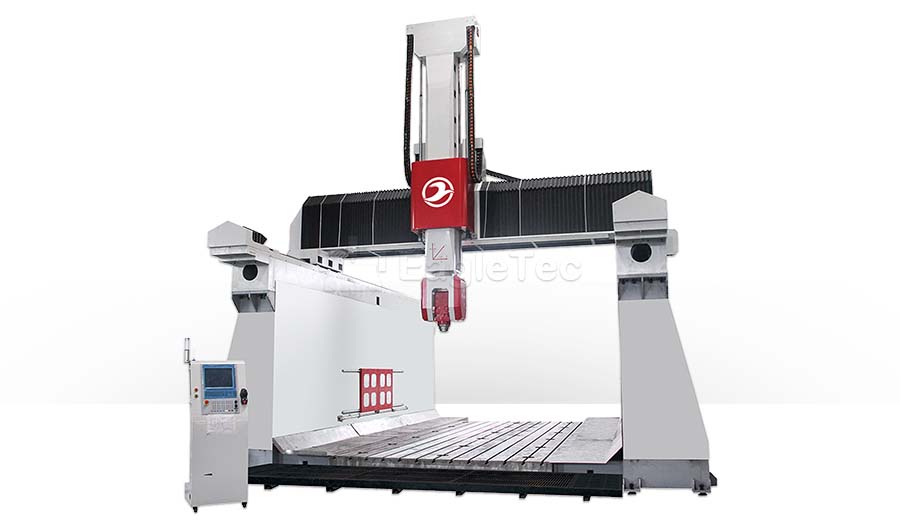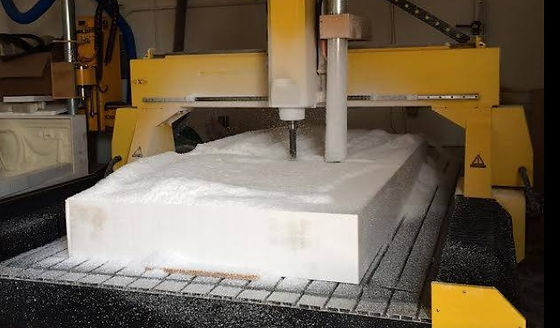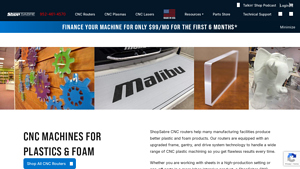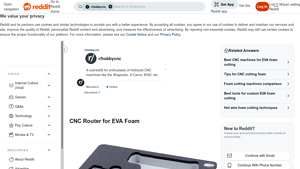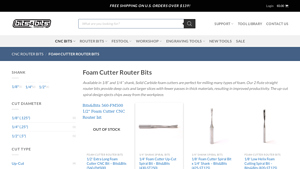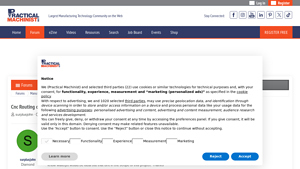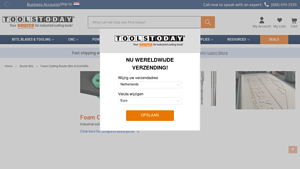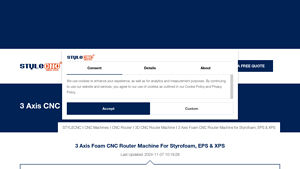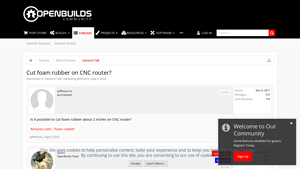Cnc Foam Router Guide: Type, Cost, Top List…
Introduction: Navigating the Global Market for cnc foam router
In an increasingly competitive landscape, sourcing the right CNC foam router can be a daunting task for international B2B buyers. As industries evolve, the demand for precision and efficiency in foam cutting applications has surged, making it crucial for manufacturers in regions like Africa, South America, the Middle East, and Europe to select equipment that not only meets their production needs but also aligns with their budgetary constraints. This guide offers a comprehensive exploration of CNC foam routers, detailing the various types available, their specific applications, and key factors to consider when vetting suppliers.
From entry-level models ideal for small-scale operations to industrial-grade machines designed for high-volume production, understanding the spectrum of options is essential for making informed decisions. Additionally, this guide delves into the intricacies of cost considerations, maintenance requirements, and the potential for in-house production to improve operational efficiency. By equipping B2B buyers with actionable insights and practical advice, we aim to empower them to navigate the global market effectively, ensuring they invest in CNC foam routers that enhance productivity and drive business growth. Whether you are looking to streamline your manufacturing process or innovate product design, this resource is your key to successful sourcing in the CNC foam router market.
Understanding cnc foam router Types and Variations
| Type Name | Key Distinguishing Features | Primary B2B Applications | Brief Pros & Cons for Buyers |
|---|---|---|---|
| Industrial Series | High precision, robust construction, advanced drive systems | Prototyping, mass production of foam parts | Pros: Durable, high output; Cons: Higher initial investment |
| Entry-Level Routers | Affordable, user-friendly, basic features | Small-scale operations, hobbyist projects | Pros: Lower cost, easy to use; Cons: Limited features and capacity |
| PRO Series | Advanced technology, high-speed capabilities | Complex designs, large projects | Pros: Fast production, versatile; Cons: Requires skilled operators |
| Custom CNC Routers | Tailored to specific needs, variety of configurations | Unique foam shapes, specialized applications | Pros: Customizable, fits specific needs; Cons: Longer lead time and potentially higher cost |
| Hot Wire Foam Cutters | Specialized for cutting softer foams using heat | Architectural models, props, and signage | Pros: Clean cuts, minimal waste; Cons: Limited to specific foam types |
What Are the Characteristics of Industrial Series CNC Foam Routers?
Industrial Series CNC foam routers are designed for high precision and durability, making them ideal for manufacturing environments that require consistent output. These routers feature advanced drive systems and robust construction, allowing them to handle large volumes of foam machining without compromising quality. B2B buyers should consider the initial investment cost against the long-term benefits of increased production efficiency and lower maintenance needs.
How Do Entry-Level Routers Serve Small Businesses?
Entry-Level Routers are perfect for small businesses or hobbyists looking for an affordable entry point into CNC foam routing. They offer user-friendly interfaces and basic features that allow users to start machining foam without extensive training. However, while they are cost-effective, buyers should be aware of their limitations in terms of capacity and features, which may not support larger or more complex projects.
What Makes PRO Series CNC Routers a Strong Choice for Complex Projects?
The PRO Series CNC routers are engineered for high-speed capabilities and advanced technology, making them suitable for complex designs and large-scale projects. They are capable of handling various materials and thicknesses, providing versatility for manufacturers. Buyers should consider their operational needs and the skill level of their workforce, as these routers may require more advanced training to operate effectively.
Why Should Businesses Consider Custom CNC Routers?
Custom CNC routers can be tailored to meet specific manufacturing needs, offering a variety of configurations to handle unique foam shapes and specialized applications. This adaptability makes them an attractive option for businesses looking to create bespoke products. However, buyers should factor in longer lead times and potentially higher costs when opting for customized solutions.
What Are the Advantages of Hot Wire Foam Cutters?
Hot Wire Foam Cutters specialize in cutting softer foam materials using heated wires, providing clean cuts with minimal waste. They are particularly useful in applications such as architectural modeling and signage. While they excel in specific foam types, buyers should note that their functionality is limited to softer foams, which may not suit all production needs.
Key Industrial Applications of cnc foam router
| Industry/Sector | Specific Application of cnc foam router | Value/Benefit for the Business | Key Sourcing Considerations for this Application |
|---|---|---|---|
| Packaging | Manufacturing custom packaging foams | Reduces material waste and enhances product protection | Look for routers with vacuum tables for stability and precision. |
| Aerospace | Creating prototypes and molds for aircraft parts | Accelerates product development and ensures design accuracy | Ensure the CNC router can handle high-density materials and complex shapes. |
| Automotive | Producing lightweight components and interior parts | Improves fuel efficiency and reduces manufacturing costs | Consider routers that offer various spindle configurations for versatility. |
| Architecture & Design | Fabricating architectural models and decorative elements | Enhances design visualization and client presentations | Assess the machine’s ability to work with different foam densities and sizes. |
| Signage & Display | Crafting custom signs and displays | Increases brand visibility and allows for creative designs | Ensure compatibility with various foam types and cutting tools for clean edges. |
How is CNC Foam Routing Applied in Packaging?
In the packaging industry, CNC foam routers are employed to manufacture custom packaging solutions that protect delicate instruments and electronics. By utilizing these routers, businesses can create tailored foam inserts that fit products precisely, minimizing movement during transport. This not only reduces material waste but also enhances product protection, leading to fewer damages and returns. International buyers should prioritize sourcing routers with advanced vacuum tables to ensure stability and precision during the cutting process, especially when dealing with varied foam densities.
What Role Does CNC Foam Routing Play in Aerospace Applications?
The aerospace sector benefits significantly from CNC foam routers, particularly in creating prototypes and molds for aircraft parts. These routers allow manufacturers to produce accurate and complex designs quickly, which is essential in the fast-paced aerospace industry. By streamlining the prototyping process, companies can bring innovations to market faster while ensuring compliance with stringent safety standards. Buyers in this sector should look for machines capable of handling high-density materials and intricate designs to meet their specific requirements.
How is CNC Foam Routing Revolutionizing Automotive Manufacturing?
In automotive manufacturing, CNC foam routers are crucial for producing lightweight components and interior parts that contribute to overall vehicle efficiency. These routers enable manufacturers to create parts that are not only lighter but also more cost-effective compared to traditional manufacturing methods. This is particularly important as the industry shifts towards more sustainable practices. When sourcing CNC routers, automotive manufacturers should consider those with versatile spindle configurations, allowing for the machining of various foam types and designs.
How is CNC Foam Routing Enhancing Architectural Design?
CNC foam routers are widely used in architecture and design for fabricating detailed models and decorative elements. These machines allow architects to create accurate representations of their designs, facilitating better visualization and client presentations. The precision offered by CNC routers ensures that even the most intricate designs can be realized effectively. Buyers in this sector should evaluate routers based on their ability to work with different foam densities and sizes, which is essential for producing high-quality architectural models.
What Benefits Does CNC Foam Routing Provide in Signage and Display?
In the signage and display industry, CNC foam routers are employed to craft custom signs and promotional displays. These routers enable businesses to create eye-catching designs that enhance brand visibility and attract customer attention. The precision cutting capabilities ensure clean edges and detailed features, which are vital for high-quality presentation. When sourcing CNC routers for this application, companies should ensure compatibility with various foam types and cutting tools to achieve the desired aesthetic and functional outcomes.
3 Common User Pain Points for ‘cnc foam router’ & Their Solutions
Scenario 1: Precision Cutting Challenges with Various Foam Types
The Problem: B2B manufacturers often face the challenge of achieving precision in foam cutting, particularly when working with diverse foam types such as high-density urethane or lightweight polyethylene. The issue often arises due to inconsistent machine calibration or inadequate tooling, leading to jagged edges and increased material waste. This not only reduces product quality but can also extend lead times, impacting customer satisfaction and overall production efficiency.
The Solution: To address precision cutting challenges, it’s essential to invest in CNC foam routers equipped with vacuum tables that stabilize the material during cutting. This setup ensures that the foam remains securely in place, reducing vibration and enhancing accuracy. Additionally, choose routers that allow for easy tooling changes to accommodate various foam types. Implement a routine maintenance schedule to periodically calibrate the machine, ensuring it operates at optimal performance. Regularly test and adjust feed rates and cutting speeds based on the foam density, which can significantly improve the cutting quality and reduce waste.
Scenario 2: High Setup Costs and Operational Downtime
The Problem: Many companies are deterred by the high upfront costs associated with CNC foam routers, especially when considering additional investments for software, tooling, and maintenance. Furthermore, new buyers often struggle with setup and operational downtime during the initial commissioning phase, causing delays that can impact production schedules and profitability.
The Solution: To mitigate costs, consider exploring financing options or commissioning a comprehensive training program from the CNC router manufacturer. Manufacturers often provide detailed training that covers everything from machine setup to optimal software usage, greatly reducing the learning curve and downtime. Additionally, look for CNC routers with modular designs that allow for incremental upgrades. This makes it possible to spread the initial investment over time, allowing for financial flexibility while still enhancing production capabilities. Focus on choosing a router that comes with robust technical support, ensuring assistance is available during the critical setup phase.
Scenario 3: Limited Technical Support and Maintenance Knowledge
The Problem: A significant pain point for manufacturers is the lack of accessible technical support and maintenance knowledge for CNC foam routers. When issues arise, companies may find it challenging to locate the right troubleshooting resources or may experience long response times from vendors, leading to increased operational disruptions.
The Solution: Establish a proactive relationship with your CNC router supplier by selecting a vendor that offers lifetime technical support and extensive online resources, such as tutorials and FAQs. Look for suppliers that provide on-site training sessions to upskill your maintenance staff, creating a team knowledgeable about the machine’s functionalities and troubleshooting. Additionally, implementing a preventative maintenance program can aid in identifying potential issues before they escalate, ensuring continuous operation. Encourage your team to keep detailed logs of any machine performance discrepancies, which can be invaluable for quickly addressing problems with the supplier’s support team.
Strategic Material Selection Guide for cnc foam router
What Are the Key Materials for CNC Foam Routers?
When selecting materials for use with CNC foam routers, it is essential to consider the properties, advantages, disadvantages, and specific application impacts of each material. This guide analyzes four common materials: Expanded Polystyrene (EPS), Polyurethane Foam (PU), Polyethylene Foam (PE), and Acrylic Glass (PMMA). Each material presents unique characteristics that can significantly influence manufacturing processes and end-product quality.
Expanded Polystyrene (EPS): Versatile and Lightweight
Key Properties: EPS is a lightweight, rigid foam material with excellent thermal insulation properties. It is resistant to moisture and has a low density, making it easy to handle.
Pros & Cons: EPS is cost-effective and widely used in packaging and insulation applications. However, it is not as durable as other materials and can be prone to deformation under pressure. Its manufacturing complexity is relatively low, but it may not be suitable for high-stress applications.
Impact on Application: EPS is compatible with various CNC foam routing tasks, including packaging foams and architectural models. Its low weight makes it ideal for prototypes but limits its use in structural applications.
International Considerations: B2B buyers should ensure compliance with local regulations regarding foam materials, particularly those related to environmental impact. In regions like Europe and the Middle East, adherence to standards such as DIN and ASTM is crucial.
Polyurethane Foam (PU): Durable and Flexible
Key Properties: PU foam is known for its excellent resilience, flexibility, and durability. It can withstand higher temperatures and pressures compared to EPS.
Pros & Cons: The flexibility of PU foam allows for a wide range of applications, from furniture to automotive components. However, it is generally more expensive than EPS and may require more complex manufacturing processes.
Impact on Application: PU foam is suitable for applications that require cushioning and support, such as mattresses and protective packaging. Its versatility makes it a preferred choice for various industries.
International Considerations: Buyers should be aware of the different grades of PU foam available and their compliance with international safety standards. In markets like Brazil and Saudi Arabia, understanding local preferences for material quality can impact purchasing decisions.
Polyethylene Foam (PE): Lightweight and Water-Resistant
Key Properties: PE foam is known for its lightweight nature and excellent water resistance. It is also resistant to chemicals and UV radiation.
Pros & Cons: The durability and flexibility of PE foam make it ideal for packaging and insulation. However, it can be more expensive than EPS and may not provide the same level of cushioning as PU foam.
Impact on Application: PE foam is commonly used for protective packaging and insulation in various industries, including electronics and construction. Its water resistance makes it suitable for outdoor applications.
International Considerations: Compliance with international standards for packaging materials is essential, especially for buyers in Europe and the Middle East. Understanding local regulations regarding chemical resistance and environmental impact can guide material selection.
Acrylic Glass (PMMA): High Clarity and Versatility
Key Properties: PMMA is a transparent thermoplastic with excellent clarity and UV resistance. It is more rigid than foam materials but offers high impact resistance.
Pros & Cons: PMMA is ideal for applications requiring transparency, such as displays and signage. However, it is more expensive than foam materials and can be challenging to work with due to its rigidity.
Impact on Application: PMMA is suitable for CNC routing applications that require precision and aesthetic appeal, such as architectural models and decorative items. Its compatibility with various cutting tools enhances its versatility.
International Considerations: B2B buyers should consider the impact of local regulations on the use of PMMA, especially concerning environmental standards in Europe and South America. Ensuring compliance with relevant certifications can facilitate smoother market entry.
Summary Table of Material Selection for CNC Foam Routers
| Material | Typical Use Case for cnc foam router | Key Advantage | Key Disadvantage/Limitation | Relative Cost (Low/Med/High) |
|---|---|---|---|---|
| Expanded Polystyrene (EPS) | Packaging, insulation, architectural models | Lightweight and cost-effective | Less durable, prone to deformation | Low |
| Polyurethane Foam (PU) | Furniture, automotive components | Excellent resilience and flexibility | Higher cost, complex manufacturing | Med |
| Polyethylene Foam (PE) | Protective packaging, insulation | Water-resistant and durable | More expensive than EPS | Med |
| Acrylic Glass (PMMA) | Displays, signage, decorative items | High clarity and UV resistance | Expensive, challenging to work with | High |
This strategic material selection guide provides essential insights for international B2B buyers, emphasizing the importance of understanding material properties, application impacts, and compliance with local standards.
In-depth Look: Manufacturing Processes and Quality Assurance for cnc foam router
What Are the Key Manufacturing Processes for CNC Foam Routers?
The production of CNC foam routers involves several intricate manufacturing processes that ensure precision, durability, and usability. Typically, these processes can be categorized into material preparation, forming, assembly, and finishing.
Material Preparation: How Are Raw Materials Readied for Production?
The first step in the manufacturing process is material preparation. High-quality raw materials, such as aluminum for frames, steel for structural components, and various composite materials for CNC router tables, are sourced from certified suppliers. The materials may undergo initial inspections to assess their quality and compliance with industry standards. This step is critical to ensure that subsequent manufacturing stages yield the expected levels of performance and durability.
How Are CNC Foam Routers Formed?
Forming encompasses multiple methods used to shape and assemble the components of the CNC foam router. Precision machining techniques, such as CNC milling and laser cutting, are often employed to create components with high dimensional accuracy. During this phase, operators utilize sophisticated software to generate G-code, which provides instructions for the CNC machines to follow, thereby ensuring intricate designs are replicated with ease.
Additionally, welding or bolting techniques are common for joining mechanical parts, reinforcing the structural integrity of the router. Some manufacturers opt for modular designs that allow for easy part replacement and upgrades.
What Assembly Techniques Ensure Quality and Performance?
Following the forming stage, assembly takes place in a controlled environment. This typically involves the integration of the machine’s critical components, including the drive system, controllers, and vacuum tables essential for foam stability during cutting.
Automated assembly systems might be employed to ensure consistency. Moreover, skilled labor is essential to verify that each assembly meets the specified tolerances through manual checks. Quality-focused setups often include continuous line inspections to catch discrepancies early in the assembly process.
What Finishing Touches Are Applied to CNC Foam Routers?
The finishing stage adds the final touches to the routers. These touches may include surface coating for corrosion resistance, application of decals for branding, and comprehensive cleaning to prepare the machinery for shipping. Aesthetic enhancements, although secondary to functionality, can positively impact a buyer’s perception, making it essential even in B2B scenarios.
How Is Quality Assured in CNC Foam Router Manufacturing?
Quality assurance (QA) is integral to ensuring a CNC foam router meets both customer expectations and regulatory requirements. Various international and industry-specific standards guide this process.
What Are the Relevant International Standards for CNC Foam Routers?
Manufacturers often adhere to international quality standards like ISO 9001, which stresses customer satisfaction and continuous improvement. Compliance with CE markings becomes crucial when selling within European markets, while API standards might be relevant for manufacturers targeting oil and gas applications. Adhering to these standards not only enhances product credibility but also ensures that the manufacturing processes satisfy global quality benchmarks.
What Quality Control Checkpoints Are Involved in the Process?
Quality control checkpoints are embedded throughout the CNC foam router manufacturing lifecycle. Key checkpoints include:
- Incoming Quality Control (IQC): This is where received materials are inspected for quality before they enter the manufacturing process.
- In-Process Quality Control (IPQC): Inspections occur at various stages of production to ensure that components align with specifications.
- Final Quality Control (FQC): The last phase verifies the entire assembly against predefined quality criteria, ensuring that the finished product is devoid of defects.
Common testing methods during these checkpoints often encompass dimensional checks using calibrated measurement tools, functionality tests on assembled systems, and performance trials under load conditions.
How Can B2B Buyers Verify Supplier Quality Control Procedures?
For B2B buyers, particularly those in regions such as Africa, South America, the Middle East, and Europe, verifying a supplier’s quality control is paramount. There are several approaches to ensure effective verification:
- Conducting Audits: A site audit can provide insights into the manufacturing processes, equipment condition, and staff competency.
- Requesting Quality Reports: Suppliers should be willing to provide compliance certifications, inspection reports, and records of past audits.
- Engaging Third-Party Inspection Services: Independent inspectors can evaluate the manufacturing facilities and validate the supplier’s claims regarding their quality control processes.
Are There Nuances in Quality Control for International Buyers?
B2B buyers must navigate various nuances unique to their regions. For instance, documentation requirements may differ by country, impacting how quality is demonstrated. Conversely, international partnerships often hinge on mutual understanding and transparency regarding quality standards.
Buyers from emerging markets may face challenges regarding access to information on suppliers. Engaging local distributors or consultants with knowledge of the industry can streamline the purchasing process and ensure compliance with local regulations.
Conclusion: Why Focus on Quality in CNC Foam Router Procurement?
Investing time and resources into understanding manufacturing processes and quality assurance can significantly influence the long-term success of CNC foam router procurement. For international buyers, ensuring that suppliers adhere to stringent quality standards safeguards against costly errors and enhances product reliability. By focusing on comprehensive audits, quality verification procedures, and the evolution of manufacturing techniques, businesses can streamline their processes and ensure they receive high-performing CNC foam routers tailored to their specific needs.
Practical Sourcing Guide: A Step-by-Step Checklist for ‘cnc foam router’
Introduction
In the competitive landscape of manufacturing, procuring the right CNC foam router is critical for enhancing production efficiency and product quality. This guide provides a structured checklist to assist B2B buyers in making informed decisions when sourcing CNC foam routers, ensuring that you acquire a machine that meets your specific needs and industry standards.
Step 1: Define Your Technical Specifications
Clearly outlining your technical specifications is the foundation of a successful procurement process. Consider factors such as the types of foam materials you will be working with, the thickness of the materials, and the desired precision of cuts. Understanding these requirements will help you narrow down the features needed in a CNC router, such as spindle speed and cutting area.
Step 2: Research Available Models and Brands
With a variety of models and brands available, conducting thorough research is essential. Look for machines that are specifically designed for foam cutting, as they will include features like vacuum tables for stability and specialized cutting bits. Pay attention to the brand reputation and customer reviews to gauge performance and reliability.
Step 3: Evaluate Potential Suppliers
Before committing to a supplier, it’s crucial to conduct a comprehensive evaluation. Request company profiles, client testimonials, and case studies from businesses in your industry or region. This will provide insights into their experience and reliability, ensuring you choose a supplier with a proven track record.
Step 4: Verify Technical Support and Training
The level of technical support and training offered by the supplier can significantly impact your operational efficiency. Ensure that the supplier provides ongoing support, including setup assistance and troubleshooting. Additionally, inquire about training programs for your team, as proper training can maximize the machine’s capabilities and minimize downtime.
Step 5: Assess Customization Options
Customization options can enhance the functionality of your CNC foam router. Discuss with suppliers the possibility of tailoring the machine to suit your specific production needs, such as additional tooling or automation features. Customization can lead to improved productivity and better alignment with your manufacturing processes.
Step 6: Review Warranty and Maintenance Plans
A robust warranty and maintenance plan are essential for protecting your investment. Review the terms of the warranty offered by the supplier, including what is covered and the duration. Additionally, inquire about routine maintenance services and support to ensure your CNC router operates optimally over time.
Step 7: Analyze Total Cost of Ownership
Finally, consider the total cost of ownership (TCO) when evaluating different CNC foam routers. This includes not only the initial purchase price but also ongoing operational costs such as energy consumption, maintenance, and potential downtime. A comprehensive TCO analysis will help you make a more informed financial decision that aligns with your budget and production goals.
By following this step-by-step checklist, B2B buyers can navigate the complexities of sourcing CNC foam routers, ensuring they select a machine that enhances their production capabilities and meets their operational needs.
Comprehensive Cost and Pricing Analysis for cnc foam router Sourcing
What Are the Key Cost Components in CNC Foam Router Sourcing?
When considering the procurement of CNC foam routers, understanding the cost structure is essential for effective budgeting and decision-making. The primary cost components include:
-
Materials: The quality and type of materials used in the construction of CNC routers significantly influence costs. High-grade steel and advanced components can increase the initial investment but often result in better durability and performance.
-
Labor: Labor costs encompass both the workforce involved in manufacturing the routers and the skilled technicians needed for setup and maintenance. In regions with varying labor costs, this can impact the overall price.
-
Manufacturing Overhead: This includes costs related to the factory operations, such as utilities, maintenance, and equipment depreciation. A well-optimized production facility can lead to reduced overhead costs.
-
Tooling: Specialized tooling for CNC foam routers, such as custom bits and fixtures, adds to the initial costs. The complexity of the tooling required for specific applications can vary greatly.
-
Quality Control (QC): Rigorous QC processes ensure that machines meet industry standards. This may involve additional testing and certification, which can increase costs but provide peace of mind regarding quality and reliability.
-
Logistics: Shipping and handling costs are crucial, especially for international buyers. The choice of shipping methods and associated customs duties can significantly influence the total expenditure.
-
Margin: Suppliers typically add a profit margin to cover their operational costs and risks. This margin can vary based on market demand and competition.
How Do Price Influencers Affect CNC Foam Router Costs?
Several factors influence the pricing of CNC foam routers, which potential buyers should consider:
-
Volume/MOQ: Larger orders often qualify for discounts due to economies of scale. Understanding the minimum order quantities (MOQ) can help negotiate better prices.
-
Specifications and Customization: Custom-built routers tailored to specific applications may incur higher costs due to the need for specialized engineering and manufacturing processes.
-
Materials Used: The type of foam being processed, such as high-density urethane or polyethylene, may dictate the specifications and, consequently, the pricing of the CNC routers.
-
Quality and Certifications: Machines that meet international quality standards and certifications may command higher prices but can also lead to lower maintenance costs and improved performance.
-
Supplier Factors: The reputation and reliability of the supplier can influence pricing. Established suppliers with a track record of quality may charge a premium.
-
Incoterms: The agreed terms of shipping and delivery can affect costs. For instance, choosing a DDP (Delivered Duty Paid) Incoterm may lead to higher upfront costs but can simplify the import process.
What Are Some Essential Buyer Tips for CNC Foam Router Sourcing?
When sourcing CNC foam routers, especially for international markets such as Africa, South America, the Middle East, and Europe, consider the following strategies:
-
Negotiate Smartly: Always explore negotiation options with suppliers. A clear understanding of your budget and requirements can provide leverage in discussions.
-
Focus on Cost-Efficiency: Evaluate the Total Cost of Ownership (TCO) rather than just the purchase price. This includes maintenance, operational costs, and potential downtime.
-
Understand Pricing Nuances: International buyers should be aware of currency fluctuations, import taxes, and tariffs that may affect the final price. Engaging local experts or consultants can provide valuable insights.
-
Leverage Supplier Support: Choose suppliers that offer robust support and training. This can reduce the learning curve and enhance productivity, ultimately saving costs.
-
Assess Long-Term Value: Consider the longevity and durability of the machine. Investing in a higher-quality CNC router may yield better returns over time through reduced maintenance and downtime.
Conclusion
Sourcing CNC foam routers requires a thorough understanding of the various cost components and pricing influencers. By applying strategic purchasing practices and focusing on total cost efficiency, buyers can make informed decisions that align with their operational needs and budget constraints.
Alternatives Analysis: Comparing cnc foam router With Other Solutions
Exploring Alternatives to CNC Foam Routers
In the landscape of manufacturing and fabrication, CNC foam routers stand out for their precision and versatility in cutting various foam materials. However, businesses may also consider alternative solutions that can achieve similar results, depending on their specific requirements and constraints. Below, we compare CNC foam routers with two viable alternatives: hot wire foam cutting machines and manual foam cutting tools.
| Comparison Aspect | CNC Foam Router | Hot Wire Foam Cutter | Manual Foam Cutting Tools |
|---|---|---|---|
| Performance | High precision and speed for complex shapes | Suitable for straight cuts; less precise | Variable precision; dependent on operator skill |
| Cost | $11,495 – $40,350 | $1,500 – $5,000 | $50 – $500 |
| Ease of Implementation | Requires setup and programming | Quick setup, minimal training needed | Simple to use, but labor-intensive |
| Maintenance | Regular maintenance needed for optimal performance | Low maintenance; occasional wire replacement | Minimal maintenance; tool replacement only |
| Best Use Case | Complex designs, large production runs | Straight cuts, less complex shapes | Small projects, prototyping, low volume |
What Are the Advantages and Disadvantages of Hot Wire Foam Cutters?
Hot wire foam cutters are effective for cutting foam with straight lines and can handle various densities of foam. The primary advantage is their lower cost and ease of use, making them an appealing option for smaller businesses or those with less complex cutting needs. However, they lack the precision and capability to handle intricate designs, which limits their application in high-end production environments.
How Do Manual Foam Cutting Tools Compare?
Manual foam cutting tools, such as knives or saws, are the most affordable option and require minimal investment. They are particularly useful for prototyping or small-scale projects where precision is not paramount. However, the effectiveness of these tools heavily relies on the skill and experience of the operator, leading to inconsistent results. Additionally, they are labor-intensive and may not be suitable for high-volume production.
Making the Right Choice for Your Business Needs
When evaluating the best cutting solution for your operations, consider factors such as production volume, design complexity, and budget constraints. CNC foam routers are ideal for businesses that require high precision and the ability to produce complex shapes efficiently. In contrast, hot wire cutters and manual tools can serve smaller operations or less demanding applications effectively.
Ultimately, the right choice will align with your specific requirements, including the desired output quality, production capacity, and available resources. By thoroughly assessing these factors, B2B buyers can make informed decisions that will enhance their operational efficiency and product quality.
Essential Technical Properties and Trade Terminology for cnc foam router
What Are the Key Technical Properties of CNC Foam Routers?
Understanding the technical properties of CNC foam routers is essential for B2B buyers looking to enhance their manufacturing capabilities. Here are some critical specifications to consider:
1. Material Grade
CNC foam routers are often constructed from high-grade materials such as aluminum or steel, which ensure durability and precision. High-grade materials resist wear and tear, resulting in longer machine life and reduced maintenance costs. For buyers, investing in machines built from superior materials can lead to better long-term ROI.
2. Tolerance Levels
Tolerance refers to the allowable deviation from a specified dimension. In CNC foam routing, tight tolerances (often within ±0.01 mm) are crucial for producing high-quality parts. This precision is particularly important in applications like medical devices and automotive parts, where even minor discrepancies can impact functionality. Buyers should prioritize machines capable of maintaining stringent tolerance levels to ensure product quality.
3. Cutting Speed and Feed Rate
Cutting speed is the rate at which the router bit moves through the material, while feed rate is the speed at which the material is fed into the router. Higher cutting speeds and feed rates can significantly increase productivity, allowing manufacturers to fulfill larger orders in less time. For B2B buyers, understanding these rates can help in selecting machines that align with their production demands.
4. Vacuum Table System
A robust vacuum table system is essential for securely holding foam materials during cutting. This system minimizes movement and vibration, which can lead to inaccuracies in cuts. Investing in routers equipped with advanced vacuum technology is vital for companies seeking consistent results, especially when working with lightweight or porous materials.
5. Spindle Power
The spindle is the rotating component that holds the cutting tool. Spindle power, measured in horsepower (HP), is critical for determining a router’s ability to cut through different foam densities. Higher spindle power allows for faster cutting and the ability to handle tougher materials, making it a key consideration for B2B buyers focused on versatility and efficiency.
6. Axis Configuration
CNC foam routers typically come in various axis configurations (e.g., 3-axis, 4-axis, or 5-axis). Each configuration offers different capabilities, such as the ability to perform complex cuts or engravings. Understanding the specific needs of your applications will help you select the right axis configuration, enhancing your machining flexibility.
What Are Common Trade Terms in the CNC Foam Router Industry?
Familiarity with industry jargon is crucial for effective communication and negotiation in the B2B space. Here are some key terms:
1. OEM (Original Equipment Manufacturer)
An OEM refers to a company that produces parts or equipment that may be marketed by another manufacturer. In the CNC industry, knowing your OEM can help buyers ensure they are sourcing machines that meet specific quality and performance standards.
2. MOQ (Minimum Order Quantity)
MOQ is the smallest quantity of a product that a supplier is willing to sell. For B2B buyers, understanding MOQ is essential for budgeting and inventory management. It can also impact production schedules, especially if a large order is required for manufacturing consistency.
3. RFQ (Request for Quotation)
An RFQ is a document that a buyer sends to suppliers to request pricing and terms for specific products. In the CNC foam router market, submitting an RFQ allows buyers to compare options and negotiate better deals, ensuring they get the best value for their investment.
4. Incoterms
International Commercial Terms (Incoterms) are standardized terms that define the responsibilities of buyers and sellers in international trade. Understanding these terms helps B2B buyers navigate shipping logistics and costs, ensuring clarity in contracts and transactions.
5. Lead Time
Lead time refers to the amount of time from placing an order to receiving the product. In the CNC foam router market, understanding lead times is crucial for planning production schedules and ensuring timely delivery of goods to meet customer demands.
By grasping these essential technical properties and trade terminology, B2B buyers can make informed decisions that enhance their operational efficiency and overall business performance.
Navigating Market Dynamics and Sourcing Trends in the cnc foam router Sector
Global dynamics in the CNC foam router sector are shaped by several factors, making it vital for international B2B buyers—particularly those from Africa, South America, the Middle East, and Europe—to stay informed about market trends. Rapid technological advancements are taking center stage, with an increasing shift toward automation and integration of smart technologies. Buyers are gravitating toward CNC routers that offer not only precision but also flexibility to handle diverse materials, including both soft and hard foams for various applications, ranging from packaging to architectural design.
Current trends reflect a strong demand for machines capable of high-volume production while maintaining quality. As manufacturers look to optimize their supply chains, CNC routers equipped with advanced features such as automated tool changes and vacuum hold-down systems are gaining traction. Furthermore, the rise of customization capabilities marks a significant shift, enabling firms to produce one-off prototypes alongside mass production runs. This adaptability allows businesses to cater to specific client demands and market niches efficiently.
The market landscape is also influenced by regional differences. In countries like Brazil and Saudi Arabia, where local manufacturing is being bolstered through investments in industry, the need for affordable, reliable CNC solutions is particularly acute. By leveraging local sourcing strategies and competitive pricing models, international buyers can establish strong footholds in these emerging markets.
What Is the Role of Sustainability and Ethical Sourcing in the CNC Foam Router Sector?
Sustainability is becoming increasingly relevant in the B2B landscape. Buyers are more cautious about the environmental impact of their purchasing decisions, pushing manufacturers toward greener practices. The CNC foam router sector is witnessing a heightened demand for machines that are energy-efficient and designed with fewer ecological footprints. By opting for routers that utilize low-energy consumption technologies, businesses can align with both regulatory requirements and consumer expectations regarding sustainability.
Moreover, ethical sourcing practices are essential for creating a responsible supply chain. International buyers are focusing on suppliers that emphasize transparency, labor ethics, and the sourcing of environmentally certified materials. Certifications such as FSC (Forest Stewardship Council) for wood-based products and ISO 14001 for environmental management standards affirm a commitment to sustainable practices. This not only enhances brand image but also opens access to markets that prioritize sustainability.
As the industry evolves, the use of recycled materials in foam production is gaining popularity, further reducing reliance on virgin resources and contributing to a circular economy. This trend represents an opportunity for B2B buyers to differentiate themselves in a competitive market by sourcing CNC routers that employ recycled or sustainable materials.
How Has the CNC Foam Router Adapted Over Time to Meet B2B Needs?
The evolution of CNC foam routers is a fascinating journey characterized by technological advancements and shifts in market demands. Initially, traditional methods dominated foam cutting processes, often resulting in inefficiencies and limited precision. However, the introduction of CNC technology transformed the industry, allowing manufacturers to achieve high levels of accuracy and speed.
Over the years, the development of computer-aided design (CAD) software has enhanced design capabilities, enabling complex geometries to be routed with ease. This evolution is significant for market adaptation, as it allows businesses to respond quickly to changing consumer preferences and demands for customization. Furthermore, innovations in materials and cutting tools, such as specialized foam cutter bits, have improved the cutting quality, making CNC foam routers essential tools in diverse applications, from automotive parts to medical devices.
As international B2B buyers continue to navigate this dynamic landscape, understanding these trends ensures they make informed decisions that align with their operational needs and market demands.
Frequently Asked Questions (FAQs) for B2B Buyers of cnc foam router
-
How do I choose the right CNC foam router for my business needs?
Selecting the right CNC foam router involves assessing your specific production requirements, including the type of foam you’ll be cutting, the desired precision, and the volume of production. Consider the machine’s capabilities, such as its cutting speed, accuracy, and compatibility with various materials. Additionally, evaluate options for customization and automation features, such as vacuum tables and cutter configurations, which can significantly enhance productivity. Consulting with manufacturers and requesting demonstrations can also help you make an informed decision. -
What are the key features to look for in a CNC foam router?
When evaluating CNC foam routers, prioritize features such as a robust frame for stability, high-speed spindle options for efficient cutting, and precision control systems for accuracy. Look for machines equipped with vacuum tables to securely hold foam materials in place during operation. Additionally, consider models that offer easy cutter changes and automated functions to streamline workflows. Lastly, ensure that the router has a good support network for maintenance and troubleshooting. -
What materials can be effectively cut with a CNC foam router?
CNC foam routers are versatile and can cut a wide range of materials, including various types of foam such as expanded polystyrene (EPS), extruded polystyrene (XPS), polyethylene (PE), and high-density polyurethane. They are also capable of machining plastics, acrylics, and wood. The choice of material will influence the type of cutting tools and settings you should use, so it’s essential to select a router that can accommodate your specific material needs. -
How can I ensure quality assurance (QA) in my CNC foam cutting process?
To maintain high-quality output in CNC foam cutting, implement a robust QA process that includes regular machine calibration, routine maintenance checks, and systematic inspections of finished products. Utilize software that allows for precise programming and simulation before cutting. Training your operators on best practices and integrating feedback mechanisms to continually improve processes will also enhance product quality. Partnering with reliable suppliers who offer warranties and support can further reinforce your QA efforts. -
What are typical payment terms for purchasing CNC foam routers internationally?
Payment terms for international purchases of CNC foam routers often vary by supplier but generally include options such as upfront deposits, letter of credit, or payment upon delivery. It’s crucial to discuss and negotiate these terms before finalizing a purchase. Ensure that you understand the total cost, including shipping, customs duties, and any applicable taxes, to avoid unexpected expenses. Establishing clear terms in a contract can protect both parties and facilitate smoother transactions. -
What is the minimum order quantity (MOQ) for CNC foam routers?
Minimum order quantities (MOQs) for CNC foam routers can vary widely among manufacturers. Some may have a single machine as the MOQ, while others might require bulk purchases for discounted rates. When negotiating, consider your production needs and budget constraints. If your requirements are lower than the MOQ, discuss potential options for custom or smaller-scale orders, or inquire about leasing or financing solutions to meet your operational needs. -
How can I vet suppliers when sourcing CNC foam routers?
Vetting suppliers is essential for ensuring reliability and quality. Start by researching their reputation in the industry, checking reviews, and asking for customer references. Evaluate their manufacturing capabilities, certifications, and warranty policies. Consider visiting their facility if possible to assess their operations firsthand. Additionally, inquire about their after-sales support, including training and technical assistance, to ensure they can meet your ongoing needs. -
What logistics considerations should I keep in mind when importing CNC foam routers?
When importing CNC foam routers, consider shipping methods, customs regulations, and potential delays. Work with a logistics partner experienced in handling industrial machinery to facilitate smooth transportation. Ensure that you have all necessary documentation, including import permits and compliance certifications, to avoid customs issues. Additionally, factor in costs related to shipping insurance and potential duties to accurately budget for your purchase. Planning for installation and setup at your facility is also crucial for minimizing downtime.
Important Disclaimer & Terms of Use
⚠️ Important Disclaimer
The information provided in this guide, including content regarding manufacturers, technical specifications, and market analysis, is for informational and educational purposes only. It does not constitute professional procurement advice, financial advice, or legal advice.
While we have made every effort to ensure the accuracy and timeliness of the information, we are not responsible for any errors, omissions, or outdated information. Market conditions, company details, and technical standards are subject to change.
B2B buyers must conduct their own independent and thorough due diligence before making any purchasing decisions. This includes contacting suppliers directly, verifying certifications, requesting samples, and seeking professional consultation. The risk of relying on any information in this guide is borne solely by the reader.
Top 7 Cnc Foam Router Manufacturers & Suppliers List
1. ShopSabre – IS-A & IS-M Series CNC Routers
Domain: shopsabre.com
Registered: 2002 (23 years)
Introduction: IS-A Series CNC Router: Industrial Use, Commercial Use, Auto Unload, High efficiency Nested Based Sheet Processing, Starting at $99,995.00; IS-M Series CNC Router: Industrial Use, Commercial Use, Dedicated High Production, High Accuracy, Starting at $57,995.00; Industrial Series (IS): Industrial Use, Commercial Use, Starting at $40,350; IS EVA Series CNC Router: Marine/EVA Foam Applications, Start…
2. CNC Router – EVA Foam Cutting
Domain: reddit.com
Registered: 2005 (20 years)
Introduction: CNC Router for EVA Foam; Price range: $3,000 – $5,000; Recommended models: Shapeoko, X-Carve; Use case: Cutting EVA foam for various layouts; Additional requirement: 3D scanner for importing CAD files; Job sizes: 7″ x 13″ to 30″ x 30″; Need for optimal settings for clean cuts; Advice on using sharp tooling for better results.
3. BitsBits – Foam Cutter Router Bits
Domain: bitsbits.com
Registered: 2001 (24 years)
Introduction: Foam Cutter Router Bits available in 1/8″ and 1/4″ shank. Solid Carbide foam cutters designed for milling various types of foam. Features 2 flute straight router bits for deep cuts and larger slices with fewer passes, enhancing productivity. Up-cut spiral design ejects chips away from the workpiece. Specific products include: 1/2″ Extra Long Foam Cutter CNC Bit ($209.99), 1/4″ Foam Cutter Up-Cut S…
4. Grismo – Foam Cutting Techniques
Domain: practicalmachinist.com
Registered: 2000 (25 years)
Introduction: This company, Grismo – Foam Cutting Techniques, is a notable entity in the market. For specific product details, it is recommended to visit their website directly.
5. Amana Tool® – Foam Cutting Router Bits & End Mills
Domain: toolstoday.com
Registered: 1999 (26 years)
Introduction: Foam Cutting Router Bits & End Mills by Amana Tool®; designed for cutting and milling Polyurethane Foam, Polyethylene Foam, Extruded Polystyrene Foam (XPS), Expanded Polystyrene (EPS), and Neopor®; solid carbide, industrial quality; allows for deep cuts in thick materials with fewer passes; features an up-cut helix providing upward chip flow.
6. STYLECNC – 3 Axis Foam CNC Router Machine
Domain: stylecnc.com
Registered: 2015 (10 years)
Introduction: {“Product Name”: “3 Axis Foam CNC Router Machine for Styrofoam, EPS & XPS”, “Brand”: “STYLECNC”, “Model”: “STM1325F”, “Price”: {“Standard Edition”: “$8,000”, “Pro Edition”: “$20,000”}, “Stock Availability”: “360 Units in Stock Available for Sale Every Month”, “Warranty”: “One-Year Limited Warranty for Entire Machine (Extended Warranties Available for Major Parts)”, “Return Policy”: “30-Day Money B…
7. OpenBuilds – Foam Cutting Solutions
Domain: builds.openbuilds.com
Registered: 2012 (13 years)
Introduction: Foam rubber can be challenging to cut on a CNC router due to its low durometer and tendency to deflect and deform. Higher durometer polymer foams like EVA, extruded polystyrene, and rigid polyurethane can be machined effectively. Cutting foam rubber is generally not recommended; instead, grinding or using a hot knife or hot wire is preferred. For specific applications like making tires for model c…
Strategic Sourcing Conclusion and Outlook for cnc foam router
Why is Strategic Sourcing Essential for Your CNC Foam Router Needs?
In today’s competitive landscape, strategic sourcing of CNC foam routers is pivotal for international businesses aiming to enhance production efficiency and product quality. By investing in high-quality CNC routers, companies can bring production in-house, reducing costs while ensuring precision in foam cutting applications. This approach not only streamlines operations but also allows for greater flexibility in adapting to market demands.
How Can You Leverage Advanced CNC Technology?
Investing in advanced CNC foam router technology enables organizations to produce a wide range of products, from packaging to complex prototypes, with unparalleled accuracy. Reliable partners, such as ShopSabre and CAMaster, offer robust machines designed for durability and high performance. With expert technical support and customizable options, businesses can tailor solutions to meet their specific needs, ensuring optimal productivity.
What’s Next for International B2B Buyers?
As you consider your sourcing strategy, focus on suppliers that provide comprehensive support and proven technology. Whether you’re based in Africa, South America, the Middle East, or Europe, the future of your production capabilities hinges on making informed, strategic investments. Embrace the opportunity to enhance your manufacturing processes by reaching out to trusted CNC router suppliers today and positioning your business for sustained growth and innovation.
